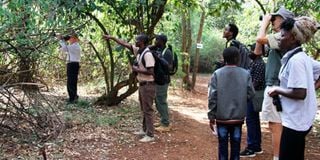Premium
Birdwatching in Ngong Road Forest

Richard Kipngeno, the leader of the Birdwatch, spots something interesting.
What you need to know:
- Less than five minutes into the walk, someone spotted a flutter of bird wings low in the tangled undergrowth.
- We also saw a Common Buzzard circling high above the trees. He was what is called a ‘passing migrant’.
‘How about doing the Nature Kenya Birdwatch tomorrow?’ Lut, my wife, asked.
My first response wasn’t very enthusiastic. ‘But we can do a Birdsit in our garden,’ I said. ‘There’s the Augur Buzzard chick to watch, and I think the Ibises are nesting again.’
But Lut had sussed the real reason for my not jumping at the idea: ‘We won’t be going very far because the walk is in the Ngong Road Forest, so you will be back in plenty of time for the grand prix. It doesn’t start till six o’clock.’
She was right.
After an early breakfast a couple of Sundays ago, I happily put on my walking boots, collected my walking stick and binoculars, and we set off. The entrance to the main section of the Ngong Road Forest is along the narrow road off to the left, immediately before the Nairobi War Cemetery.
It was very encouraging to find a group of about 30 already assembled in the car park. There were some familiar faces. Fleur Ng’weno, of course, was there. We have been on many such Sunday outings led by her.
For 49 years, she also led Nature Kenya’s Wednesday morning bird walks. Only Covid prevented her scoring her 50. My intrepid Nation travel writer colleague, Rupi Mangat, was there on Sunday, too.
The forest is quite large – 1,224 hectares. But you get a much better impression of what that means when you begin to walk across it! Close to the entrance there is an interesting signboard that offers a choice of trails: 5km, 10km, 15km, 21km – or what was comfortingly called the Family Trail.
I immediately felt that I was a family man. However, we took off following the 15km route, having been assured that anyone could peel off, as they wished, along any of the trails.
Different birds species
The story of the forest is well told in the website, www.ngongroadforest.com. It is managed by the Kenya Forest Service and the Ngong Road Forest Association, a community association formed in line with the Forest Act of 2005.
Part of the forest, called the Miotoni Section, is the other side of the Ngong Road and adjacent to the Southern Bypass section. The website incorporates the conservation plan, Green Space and the City, formulated only a year ago and inspired by what has happened in the rehabilitation of Karura Forest.
The website tells us that 113 different species of birds have been spotted within the forest. Last Sunday, we saw many of them. Less than five minutes into the walk, someone spotted a flutter of bird wings low in the tangled undergrowth. A number got down on their knees to train their binoculars better.
Frustrated, I seemed to be the only person not seeing it. But, at last, there it was – a small White-starred Robin. When I checked it out on my phone application, I was disappointed to find it described as ‘common’ – though it went on to add ‘but rather shy’.
We also saw a Common Buzzard circling high above the trees. He was what is called a ‘passing migrant’. I can well understand why all these migrating birds leave the cold of European winters; I still haven’t been given a convincing reason why they fly back all those thousands of exhausting miles. ‘They go back to breed,’ the bird experts say. Why can’t they breed here?
I was impressed at how many young Kenyans were in the group that day – and amazed at how enthusiastic and knowledgeable they are. I appreciate that both our sons (evidence that it is possible for migrants to breed in Kenya) have been much influenced by such bird walks. If you would like to know more about the Nature Kenya activities, go to their website, www.naturekenya.org.
John Fox is Chairman of iDC Email: [email protected]





